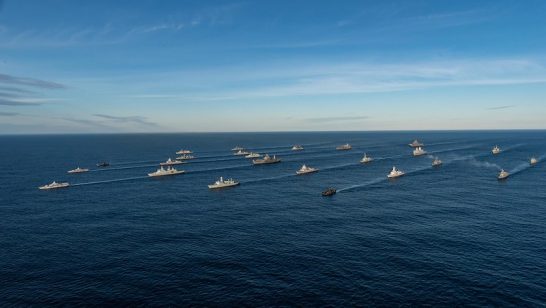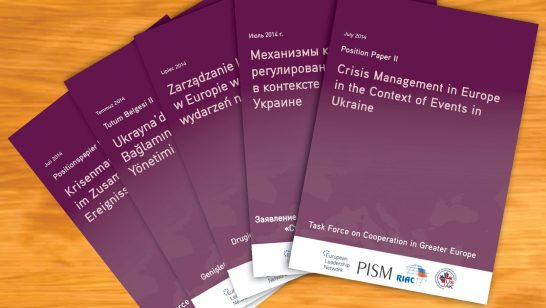
Since March 2014, Moscow’s statements, patrols of heavy bombers, and exercises, including combined snap drills of conventional and nuclear-capable forces, have gone far beyond Russia’s standard routine. They have been unusual in terms of their numbers, frequency, scale, complexity, and provocative nature. They also have often coincided with critical phases of the ongoing crisis in Ukraine, and with decisive moments when the West has been considering its response to Russian actions, such as the introduction of sanctions. Moscow has gone to great lengths to create a perception that President Vladimir Putin is “using” nuclear weapons every day, and that he can choose from a wide range of nuclear options.
Moscow is willing to use its nuclear arsenal not only as a deterrent but also as a tool of coercion, supporting a change of the status quo. Russia’s nuclear brinkmanship has strengthened the presumption that any hypothetical conflict between NATO and Russia would involve Russian nuclear threats, implicit or explicit.
At the same time, the Ukraine crisis has exposed a number of challenges to the effectiveness of NATO’s own nuclear policy. There have been recurring doubts during the crisis concerning the credibility of NATO’s nuclear deterrent, expressed even by high-ranking NATO military officers. The assurance role of NATO’s current nuclear arrangements has been questioned by those asking why US nuclear weapons are not based closer to the Alliance’s border with Russia. There have been calls for the development and deployment in Europe of nuclear-armed sea and air-launched cruise missiles, as well as concerns about whether NATO has sufficient nuclear crisis management tools to read and react to Russia’s nuclear messages. Notably, NATO communications about Russia’s nuclear ‘sabre-rattling’ appears to have been reluctant and to have come late in the day. NATO Allies and the Secretary General became more outspoken only in spring 2015 – a gap of a year since the beginning of the crisis.
The Ukraine crisis has revealed that NATO may be unprepared or unwilling to send nuclear messages of its own. Such initiative as has been taken in nuclear signalling has been taken not by NATO as a whole but by the United States which, with some Allies and partners, has conducted a number of exercises with nuclear-capable B-2 and B-52 bombers in Europe. This situation reinforces doubts as to whether all NATO leaders would be able to collectively react to nuclear contingencies and share the related risks and responsibilities. It is striking that anti-nuclear Sweden has been more eager to conduct exercises with US strategic bombers, than the nuclear Alliance as a whole.
NATO’s nuclear policy needs an update. In order to conduct it, the framework of public discussion on NATO’s nuclear adaptation needs to change as well. Currently it is dominated by extreme views: either focusing solely on conventional response, or undertaking radical steps such as deploying a greater number of more advanced nuclear weapons closer to Russia. What this dichotomy ignores is that there are a lot of options in between.
The primary task should be to upgrade NATO’s nuclear software, not its hardware. In terms of hardware, strengthened deterrence does not require going beyond keeping the US B-61 bombs and the dual capable aircraft up to date and deployed in Europe.
In examining the software, i.e. NATO’s nuclear policy, the Allies should consider the following inter-related measures:
First, NATO should rebalance its thinking to take nuclear deterrence more into account. In previous years, NATO Allies concentrated on how to further reduce the role and number of non-strategic nuclear weapons in Europe. Granted, seeking arms control agreements with Russia remains important as a possible route to achieving this outcome. And what was desirable with Russia as a prospective partner is even more desirable with Russia as a potential adversary. However, the top NATO priority should be to deter a nuclear crisis involving Russia. NATO’s new approach should be built on the premise that a renewed understanding and faith in Allied deterrence capabilities, including, critically, the willingness to use them, is a prerequisite to any successful arms control. The only way to convince Russia to decrease its reliance on nuclear weapons seems to be to deny Russia any advantage from the nuclearisation of its security policy.
Second, NATO should re-examine its nuclear crisis-management tools. The Alliance should improve its intelligence and analytical skills to be able to receive, interpret and design appropriate responses to Russia’s nuclear messages. Over the last two decades a lot of such institutional expertise at NATO has been lost. By strengthening the ability to act during a crisis NATO would reduce the risk of an inadvertent escalation that might result from misreading Russian messages or by responding inappropriately.
Third, NATO should adjust its nuclear exercise practices. It could start by being more transparent about the existing regular nuclear exercises to bolster assurance and raise public awareness. Nuclear scenarios should also be injected into crisis-management exercises, which would strengthen the ability of NATO’s decision-makers to act effectively during crises. Additionally, NATO Allies should prepare in advance non-routine forms of exercises to serve as “collective” nuclear messaging such as joint drills of US strategic bombers or allies’ dual-capable aircraft. Such exercises could be conducted if circumstances require them, and should be non-escalatory but visible and inclusive enough to signal the cohesion of the Alliance.
Fourth, NATO should refresh its declaratory policy. In particular, Allies should create a commonly agreed narrative on the role of US non-strategic nuclear weapons deployed in Europe. The credibility of NATO’s nuclear deterrence is negatively impacted by the perception of a lack of consensus on the purpose of these weapons. NATO members should explain the weapons’ political significance and reinforce the message that they believe them to be a credible response to a hypothetical threat of a Russian de-escalatory nuclear strike. While it would be perceived as a setback by those who would like to eliminate the presence of B-61 bombs in Europe, it would be a counter-argument to the proposals to base US nuclear weapons in Central and Eastern Europe or to qualitatively upgrade NATO’s nuclear posture with new capabilities.
Fifth, NATO should re-design its nuclear communication strategy. It should return to the practice of regularly communicating to the public and outside world its thinking on nuclear matters. NATO should also inform the public about the most provocative forms of Russian sabre-rattling and explain why specific actions are regarded as such. Only by going public can NATO provide a clear signal that Russia’s nuclear posturing is unacceptable, and increase international pressure on Russia. More transparency about its own activities could strengthen the Alliance’s credibility in denouncing Russia’s steps because it would provide a point of reference. Without being clear about the difference between NATO and Russian activities, there is a risk that the public may become even more vulnerable to Russia’s efforts to make its own and NATO’s and the U.S.’s actions appear equivalent.
The redesign of NATO’s nuclear policy will not be an easy task. Forging a new consensus would be difficult as the public and elites’ perceptions of nuclear weapons and nuclear deterrence vary between the NATO member states. Still, while difficult and slow, a change is possible. Indicators of it could be seen in recent US and UK calls for NATO to exercise a “transition up the escalatory ladder” as a response to close integration of Russia’s conventional and nuclear forces. Even proposing such exercises would have been unthinkable before March 2014, but now it seems like an essential step towards a more credible NATO deterrence and assurance posture.
This article is based on findings from a PISM Report: “Nuclear-Backed Little Green Men: Nuclear Messaging in the Ukraine Crisis” from July 2015. The full report is available here:http://www.pism.pl/publications/PISM-reports/Nuclear-Backed-Little-Green-Men-Nuclear-Messaging-in-the-Ukraine-Crisis
The opinions articulated above represent the views of the author(s), and do not necessarily reflect the position of the European Leadership Network or any of its members. The ELN’s aim is to encourage debates that will help develop Europe’s capacity to address the pressing foreign, defence, and security policy challenges of our time.



